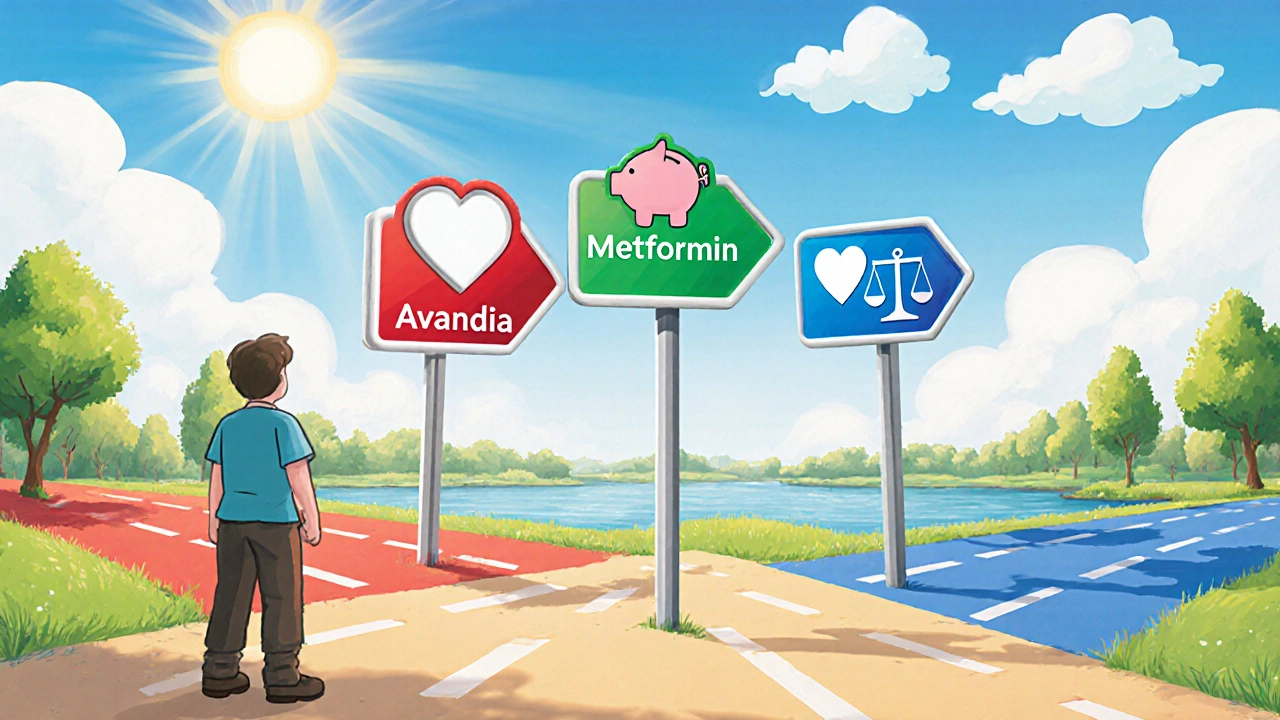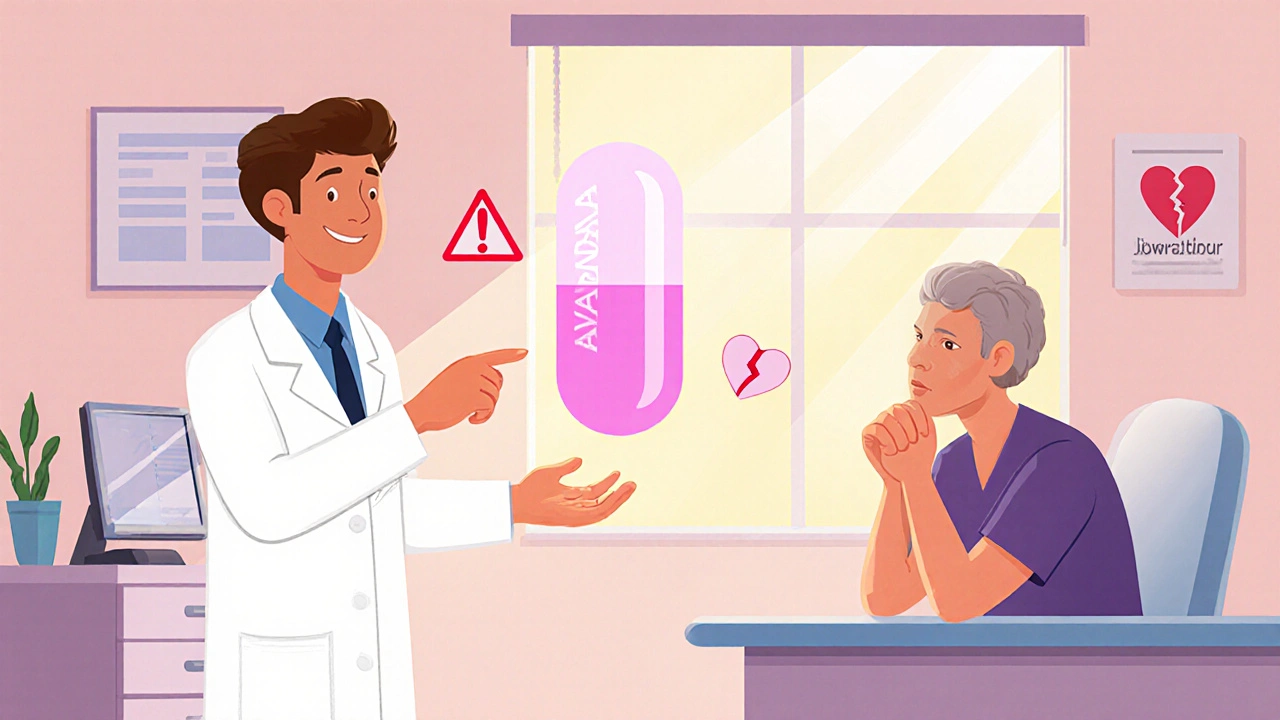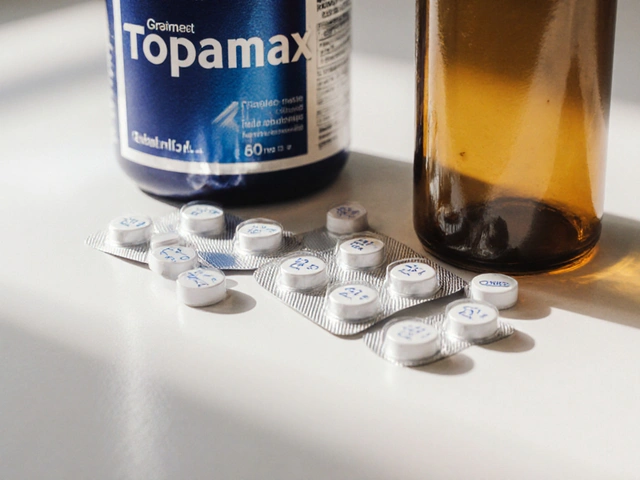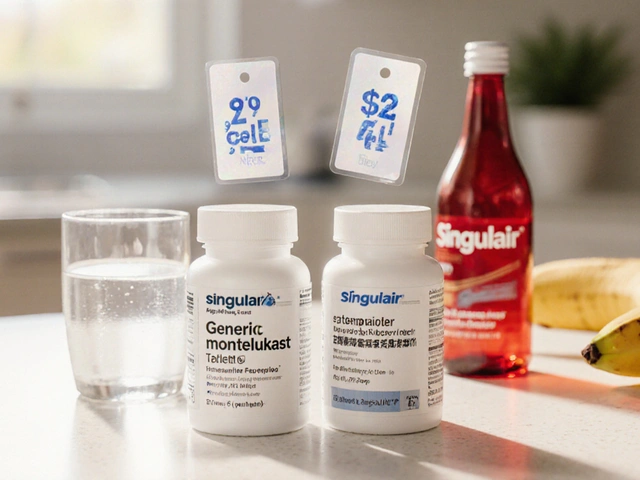Diabetes Medication Decision Guide
Personalize your diabetes treatment
Answer these questions to get personalized recommendations for alternatives to Avandia (rosiglitazone).
Recommended Alternatives
Important Considerations
Discuss these recommendations with your healthcare provider. Treatment decisions should be made in consultation with your physician based on your individual health profile.
When it comes to controlling blood sugar, many patients still wonder if Avandia is the right choice or if there are Rosiglitazone alternatives that offer better safety.
What is Avandia (Rosiglitazone)?
Rosiglitazone is marketed under the brand name Avandia. It belongs to the thiazolidinedione (TZD) class and works by activating the PPARγ receptor, which makes muscle and fat cells more responsive to insulin. Approved in the early 2000s, it quickly became a go‑to drug for patients whose blood glucose remained high despite metformin.
Despite its glucose‑lowering power, the drug drew intense scrutiny after several studies linked it to an increased risk of heart attacks and fluid retention. In 2010, the FDA added a boxed warning, and many clinicians started looking for other options.
Why clinicians look for alternatives
Three main concerns drive the search for alternatives to Avandia:
- Cardiovascular safety: Evidence suggests rosiglitazone may raise the odds of myocardial infarction by 30% compared with placebo.
- Weight gain and edema: The drug often adds a few kilograms and can cause fluid buildup, worsening heart failure symptoms.
- Regulatory pressure: Some countries have restricted its use, and insurers may require prior authorization.
Because type2 diabetes is a lifelong condition, patients and prescribers prefer agents with a clear safety profile and added benefits such as weight loss or cardiovascular protection.
Top alternatives for type2 diabetes (2025)
Below are the most widely used drug classes that clinicians consider when they want to move away from rosiglitazone.
- Metformin - The first‑line biguanide; lowers glucose by reducing hepatic production and improving peripheral uptake.
- Pioglitazone - Another TZD, but with a more favorable cardiovascular record; still carries weight‑gain risk.
- Empagliflozin - An SGLT2 inhibitor that promotes glucose excretion via urine; proven to cut cardiovascular death.
- Liraglutide - A GLP‑1 receptor agonist injected once daily; brings weight loss and strong heart‑benefit data.
- Sitagliptin - A DPP‑4 inhibitor; modest glucose drop, neutral weight effect, low hypoglycemia risk.

Head‑to‑head comparison
| Attribute | Avandia (Rosiglitazone) | Metformin | Pioglitazone | Empagliflozin | Liraglutide | Sitagliptin |
|---|---|---|---|---|---|---|
| Mechanism | PPARγ agonist (TZD) | Biguanide - ↓ hepatic gluconeogenesis | PPARγ agonist (TZD) | SGLT2 inhibition - ↑ urinary glucose excretion | GLP‑1 receptor agonist - ↑ insulin, ↓ glucagon | DPP‑4 inhibition - ↑ endogenous GLP‑1 |
| A1C reduction (average) | 0.7-1.0% | 1.0-1.5% | 0.5-0.8% | 0.5-0.7% | 0.8-1.2% | 0.5-0.7% |
| Weight effect | +2-4kg (gain) | Neutral or slight loss | +1-3kg | -1-3kg | -2-5kg | Neutral |
| Cardiovascular risk | ↑ myocardial infarction (≈30% higher) | Neutral or modest benefit | Neutral; some data suggest benefit | ↓ CV death, ↓ heart failure hospitalisation | ↓ major adverse CV events | Neutral |
| Common side‑effects | Fluid retention, edema, weight gain | GI upset, lactic acidosis (rare) | Edema, weight gain, rare bladder cancer signal | UTI, genital mycotic infections, volume depletion | Nausea, vomiting, pancreatitis (rare) | Headache, nasopharyngitis |
| Cost (UK NHS 2025) | £30‑£45 per month | £2‑£5 per month (generic) | £20‑£30 per month | £45‑£60 per month | £70‑£85 per month | £30‑£40 per month |
Choosing the right option for you
Here’s a quick decision guide:
- Heart‑risk profile: If you have a history of coronary artery disease, steer toward empagliflozin or liraglutide-both cut heart‑attack risk.
- Weight concerns: Metformin, SGLT2 inhibitors, and GLP‑1 agonists tend to promote weight loss, while TZDs (including Avandia) add weight.
- Kidney function: Metformin is safe down to an eGFR of 30ml/min; SGLT2 inhibitors require eGFR≥45ml/min for full effect.
- Injection aversion: If you dislike needles, oral agents like metformin, pioglitazone, or empagliflozin are preferable.
- Cost constraints: Generic metformin remains the cheapest and is fully reimbursed on the NHS.
Discuss these points with your clinician. The best regimen often combines two drugs-e.g., metformin plus an SGLT2 inhibitor-giving synergistic glucose control without the downsides of rosiglitazone.

How to switch safely from Avandia
Stopping rosiglitazone abruptly can cause a rebound rise in blood sugar. A typical taper plan looks like this:
- Schedule a review visit and order baseline labs (A1C, fasting glucose, liver enzymes, renal panel).
- Introduce the new agent at a low dose while keeping rosiglitazone for 1-2 weeks.
- Gradually reduce rosiglitazone by 25% each week, monitoring blood glucose daily.
- Once rosiglitazone is stopped, titrate the new medication to its target dose over 2-4 weeks.
- Re‑check A1C after 3months to confirm the switch achieved the desired control.
Patients on pioglitazone should be warned about potential fluid retention, especially if they have heart failure. Those moving to SGLT2 inhibitors need education on recognizing signs of urinary infections.
Key takeaways
- Avandia delivers decent A1C drops but carries higher cardiovascular and weight‑gain risks.
- Metformin remains the cheapest, safest first‑line option with solid evidence.
- Pioglitazone offers similar glucose‑lowering power but still adds weight; its CV profile is less worrisome than rosiglitazone.
- SGLT2 inhibitors and GLP‑1 agonists provide added heart benefits and weight loss, albeit at higher cost.
- Switching should be gradual, with lab monitoring and clear patient education.
Frequently Asked Questions
Is Avandia still prescribed in the UK?
Yes, but only as a second‑line option after metformin, and prescribers must document a clear benefit outweighing the cardiovascular risk. Many NHS trusts now require prior authorization.
Can I take rosiglitazone with metformin?
The combination is possible, but clinicians usually prefer metformin plus a newer class (SGLT2 or GLP‑1) because the added risk of heart problems is not offset by extra glucose lowering.
What makes empagliflozin a good alternative?
It reduces A1C, promotes weight loss, and, importantly, has robust data showing a 38% drop in cardiovascular death for high‑risk patients (EMPA‑REG OUTCOME trial).
Are GLP‑1 drugs like liraglutide safe for people without heart disease?
They are safe and can be used in anyone needing better glucose control, especially if weight loss is a goal. The cardiovascular benefit is an added bonus, not a requirement.
How do I know which alternative is covered by my NHS prescription?
Log into the NHS App or contact your local pharmacy. Generally, metformin, pioglitazone, and the first‑line SGLT2 inhibitor (empagliflozin) are fully funded, while GLP‑1 agonists may need a specialist’s justification.







Comments
Monika Kosa
Hey folks, you know the pharma giants love to keep us hooked on old drugs like Avandia because the more we buy, the richer they get. The hidden agenda behind the “box warning” is to scare us into switching to newer, pricier meds that line their pockets. If you look at the data, the cardiovascular risk signal was there long before regulators caught on, and the labs were quietly suppressed. That’s why I always advise patients to double‑check the source of any study they’re handed. Still, there are safer alternatives that don’t come with a secret profit motive.
Maureen Crandall
Avandia still prescribed but metformin cheap and effective
andrew bigdick
Hey everyone, just a quick heads‑up: when you’re weighing Avandia against the newer agents, think about the whole patient picture – heart risk, weight, and cost. Metformin stays the gold standard for most, and SGLT2 inhibitors add heart protection without the weight gain. If you’re on a tight budget, pioglitazone can be a middle ground, but watch for edema. Always pair the drug choice with lifestyle tweaks for the best outcome.
Shelby Wright
Whoa hold up, Andrew! You’re playing it too safe, like a boring textbook. The drama is real – imagine swapping a pill that makes you puff up like a balloon for one that actually *helps* you shed those stubborn kilos. Avandia is the villain in this saga, and the heroes are the GLP‑1 injectables, even if they sting a bit. Don’t let the “casual” vibe lull you into a bland treatment plan.
Ellen Laird
Thier claim that Avandia is a “second‑line” option is simply preposterous when you consider the plethora of avant‑garde therapeutics now at our disposal. One must eschew the pedestrian mindset and embrace the pharmaco‑logical renaissance.
rafaat pronoy
Nice rundown! 👍🏼 I’ve seen patients jump from Avandia to empagliflozin and actually feel lighter after a few weeks. Keep the info coming, it really helps us navigate the meds maze.
sachin shinde
While the presented comparison is generally accurate, it is imperative to note that the phrasing “increase the odds of myocardial infarction by 30%” should be accompanied by a confidence interval to preserve scientific rigour. Moreover, the term “fluid retention” is vague; “extracellular fluid accumulation” would be more precise. Such nuances are essential for an informed clinical decision.
Leon Wood
Great summary! For anyone on the fence, remember that switching off Avandia isn’t just about risk – it’s about reclaiming your energy and confidence. Pair the new drug with a supportive community, and you’ll see improvements faster than you think.
George Embaid
In many cultures, the fear of heart disease drives medication choices, so it’s valuable to highlight agents like empagliflozin that have proven cardiovascular benefits. At the same time, respecting patients’ financial constraints by suggesting generic metformin can build trust and adherence.
Shivaraj Karigoudar
When we dissect the pharmacodynamic profile of rosiglitazone, we observe a pronounced agonism of the peroxisome proliferator‑activated receptor gamma, which, albeit efficacious in insulin sensitization, precipitates a cascade of adipogenic transcriptional events leading to ectopic lipid deposition and subsequent hemodynamic perturbations. The meta‑analysis conducted by the Cardiometabolic Outcomes Consortium in 2023 aggregated data from over 45 randomized controlled trials, thereby furnishing a robust hazard ratio of 1.28 for major adverse cardiovascular events relative to placebo. By contrast, the sodium‑glucose cotransporter‑2 inhibitor class manifests a distinct mechanism, leveraging renal glucose reabsorption inhibition to facilitate osmotic diuresis, which not only attenuates hyperglycemia but also ameliorates intravascular volume status. Empagliflozin, in particular, has demonstrated a 38% relative risk reduction in cardiovascular mortality in the EMPA‑REG OUTCOME trial, a statistic that reverberates through current guideline algorithms. Moreover, the glucagon‑like peptide‑1 receptor agonists, exemplified by liraglutide, elicit synergistic effects on satiety pathways via hypothalamic nuclei, thereby effectuating clinically meaningful weight loss alongside glycaemic control. From a health economics perspective, the cost‑effectiveness analyses underscore that while the acquisition cost of GLP‑1 analogues is higher, the downstream savings accrued from reduced hospitalizations for heart failure offset the initial expenditure. It is also salient to acknowledge the renal protective attributes of SGLT2 inhibitors, which attenuate albuminuria progression, a pivotal factor in chronic kidney disease management. Conversely, pioglitazone, though sharing the thiazolidinedione scaffold, exhibits a more favorable cardiovascular safety signal in recent longitudinal cohorts, albeit still burdened by fluid retention risks. The clinician must therefore perform a nuanced risk‑benefit calculus, integrating patient‑specific variables such as baseline eGFR, comorbid coronary artery disease, and socioeconomic status. Patient education remains a cornerstone; informing individuals about the signs of genitourinary infections associated with SGLT2 inhibition can preempt adverse events. Finally, the therapeutic inertia often observed in primary care settings can be mitigated by interdisciplinary collaboration, wherein pharmacists, diabetes educators, and physicians co‑construct individualized regimens. In sum, the evolution of diabetes pharmacotherapy since the early 2000s has rendered rosiglitazone an increasingly obsolete option, supplanted by agents that confer both metabolic and cardiovascular advantages.
Matt Miller
Metformin still beats Avandia on cost and safety.
Fabio Max
Exactly, Matt – the price gap alone makes metformin the go‑to, especially when insurance hurdles block newer drugs.
Darrell Wardsteele
Our great American doctors know better than to rely on foreign-made pills like Avandia when home‑grown generic metformin gets the job done without the risk.
Andrea Rivarola
I tend to read these comparative tables late at night, sipping tea while pondering how each molecule fits into the larger tapestry of a patient's life. The weight gain associated with rosiglitazone feels like a silent thief, stealing confidence as much as pounds. In contrast, the modest weight loss seen with SGLT2 inhibitors offers not just a number on the scale but a psychological lift. Yet, the cost factors cannot be ignored; I have seen families make tough choices because a prescription feels like a luxury. The safety profile, especially the cardiovascular data, weighs heavily on my mind, as I recall a colleague whose patient suffered a heart event after a brief rosiglitazone course. Ultimately, I advocate for shared decision‑making, letting patients hear both the numbers and the stories behind them. It is a delicate balance, but one worth striving for.